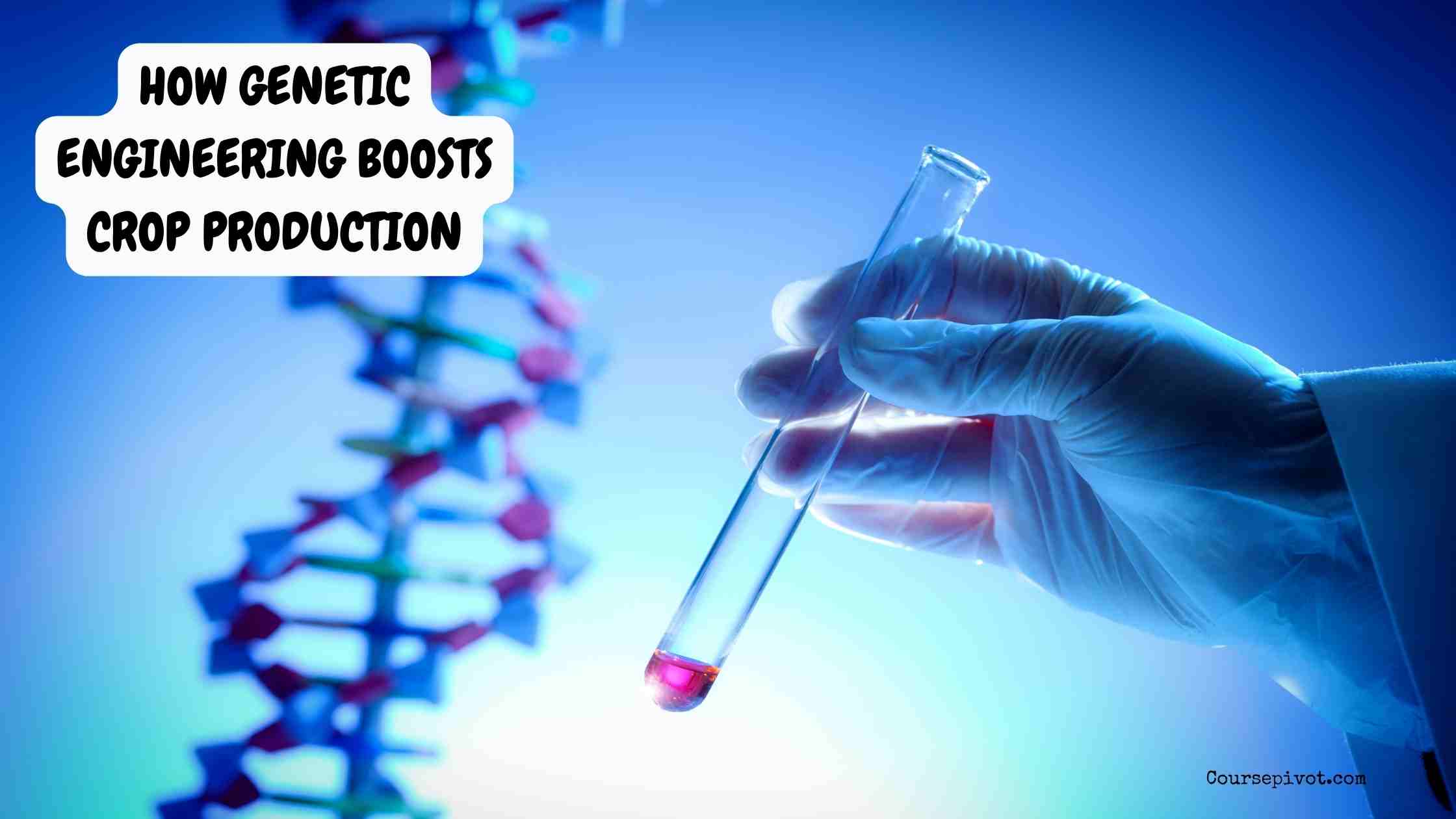
How Genetic Engineering Boosts Crop Production
What if we could grow crops that thrive in harsh conditions, resist pests, and feed millions more people? I’ve always been fascinated by how science can solve real-world problems, and genetic engineering is a game-changer for agriculture. It’s not just about tweaking plants—it’s about securing food for the future. In this blog, I’ll explain how genetic engineering can improve crop production, diving into the science and its real-world impact.
Genetic engineering involves modifying a plant’s DNA to enhance traits like yield, resilience, or nutrition. It’s a precise tool that’s revolutionizing farming. Why does this matter? Because global challenges like climate change, population growth, and shrinking farmland demand smarter ways to grow food. I’ve seen reports of farmers doubling yields with engineered crops, and it’s inspiring.
Table of Contents
This topic hits home because food security affects us all. Whether you’re a farmer, a consumer, or just someone who loves a good meal, genetic engineering shapes what’s on your plate. Let’s explore how it works and why it’s a big deal.
By the end, you’ll understand the key ways genetic engineering enhances crop production and its potential to transform agriculture. Ready to dig into the science of better crops? Let’s get started.
What Is Genetic Engineering in Agriculture?
Genetic engineering is the process of directly altering an organism’s DNA to introduce or enhance specific traits. Unlike traditional breeding, which can take years, genetic engineering is precise and fast. Scientists use tools like CRISPR to edit genes, adding or removing traits to improve crops.
In agriculture, this means creating plants that:
- Produce higher yields.
- Resist pests or diseases.
- Tolerate harsh conditions like drought or salinity.
- Offer better nutrition.
I remember reading about how engineered rice saved farmers in flood-prone areas. It’s amazing how a small DNA tweak can make such a big difference.
How Genetic Engineering Improves Crop Production
Genetic engineering boosts crop production by addressing key challenges in farming. Below, I’ll break down the main ways it enhances crops, with examples to show its impact.
Increasing Crop Yields
Higher yields mean more food from the same land. Genetic engineering achieves this by:
- Enhancing Photosynthesis: Modifying genes to make plants use sunlight more efficiently.
- Improving Growth: Engineering plants to grow faster or produce larger fruits.
- Reducing Losses: Protecting crops from pests or diseases that destroy harvests.
For example, Bt corn, engineered with a bacterial gene, resists insects, boosting yields by up to 20% in some regions. I’ve seen farmers’ stories about how these crops saved their livelihoods.
Enhancing Pest and Disease Resistance
Pests and diseases can wipe out entire harvests. Genetic engineering creates crops that fight back:
- Pest Resistance: Plants like Bt crops produce proteins toxic to specific insects but safe for humans.
- Disease Resistance: Genes are added to protect against viruses or fungi.
Take the papaya ringspot virus. In Hawaii, engineered papayas resistant to this virus revived the industry. It’s proof that genetic engineering can rescue crops from collapse.
Improving Environmental Resilience
Climate change brings droughts, floods, and extreme heat. Genetic engineering helps crops adapt:
- Drought Tolerance: Genes enable plants to survive with less water.
- Salt Tolerance: Crops can grow in salty soils, reclaiming degraded land.
- Heat Resistance: Plants withstand higher temperatures without wilting.
I was amazed by drought-tolerant maize in Africa, which helped farmers grow food during dry spells. It’s a lifeline for communities facing unpredictable weather.
- Read our blog on 10 Reasons why Electric Cars are Bad for the Environment
Boosting Nutritional Content
Genetic engineering can make crops more nutritious, addressing global malnutrition:
- Vitamin Enrichment: Adding genes to increase vitamins or minerals.
- Allergen Removal: Eliminating proteins that cause allergies.
- Better Shelf Life: Modifying genes to keep produce fresh longer.
Golden Rice, engineered to produce vitamin A, is a standout example. It’s helping combat deficiency in developing countries. I find it incredible that a single crop can improve health on such a scale.
Reducing Farming Inputs
Engineered crops often need fewer resources, saving time and money:
- Less Pesticide: Pest-resistant crops reduce chemical use.
- Fewer Fertilizers: Nitrogen-efficient plants grow well with less fertilizer.
- Lower Water Use: Drought-tolerant crops conserve water.
This not only boosts production but also makes farming more sustainable. I’ve read about farmers cutting costs with these crops, which means more profit and less environmental harm.
Real-World Impacts of Genetic Engineering
The benefits of genetic engineering go beyond the lab. Here’s how it’s transforming agriculture:
- Food Security: Higher yields and resilient crops feed growing populations.
- Farmer Livelihoods: Reduced losses and costs improve incomes.
- Environmental Benefits: Less pesticide and water use protect ecosystems.
- Global Reach: Engineered crops help farmers in diverse climates, from Africa to Asia.
I recall a documentary about Indian farmers using Bt cotton. Their yields soared, and they could afford better lives for their families. It’s a reminder of the human impact behind the science.
Wondering how this affects you? Ask yourself: Do I want affordable, sustainable food in the future? Genetic engineering is part of the answer.
Challenges and Concerns
Genetic engineering isn’t without controversy. Here are some challenges and how they’re addressed:
- Safety Concerns: Critics worry about health risks. Solution: Rigorous testing ensures engineered crops are safe to eat.
- Environmental Risks: There’s fear of crossbreeding with wild plants. Solution: Strict regulations and monitoring minimize this.
- Access Issues: Small farmers may struggle to afford engineered seeds. Solution: Nonprofits and governments are working to make seeds accessible.
I’ve had debates with friends about GMOs. While concerns are valid, the evidence shows that benefits often outweigh risks when managed carefully.
- Read our blog on How Human Impact on the Environment Can Be Positive or Negative
Growing a Better Future: Key Takeaways
Genetic engineering is a powerful tool to improve crop production, addressing challenges like pests, climate change, and malnutrition. By increasing yields, enhancing resilience, and boosting nutrition, it helps farmers grow more food sustainably. I’m inspired by how it’s already transforming lives, from drought-tolerant maize in Africa to Golden Rice fighting vitamin deficiencies.
Why should you care? Because genetic engineering shapes the future of food, making it more abundant, affordable, and sustainable. What’s stopping you from learning more about this science? Support innovation, stay informed, and consider how these crops benefit both farmers and consumers.
Summarized Answer
Genetic engineering improves crop production by modifying plant DNA to increase yields, resist pests and diseases, tolerate harsh conditions, enhance nutrition, and reduce resource use. Examples like Bt corn, Golden Rice, and drought-tolerant maize show how it boosts food security, farmer incomes, and sustainability while addressing global challenges like climate change and malnutrition.
Cite this article
You can copy and paste your preferred citation format below.
Martin, L. & Arquette, E.. (2025, June 2). How Genetic Engineering Boosts Crop Production. Coursepivot.com. https://coursepivot.com/blog/how-genetic-engineering-boosts-crop-production/



